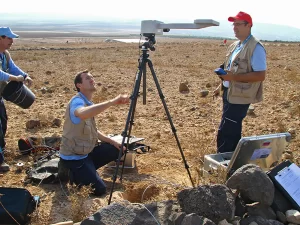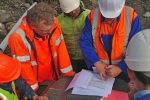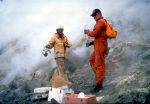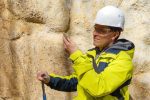| Seismologist Key Stats | |
|---|---|
| Avg. Salary / year | $88,640 |
| Avg. Pay / hour | $42.62 |
| Education | 4+ Years |
| Job Outlook | 6% |
| Total Employed | 84,930 |
Seismologists are specialized professionals under a branch of the geoscience who focus on the study of the internal movement of the earth in the forms of earthquakes and seismic movement.
This includes the movement of the plate tectonics that causes earthquakes and the composition of the earth’s crust.
Many of these individuals work in the oil industry helping companies search and extract oil for consumer use.
Individuals who want to become a Seismologist will need a combination of education and personal characteristics to succeed in this profession.
Individuals will have a high interest in the physical sciences, have physical stamina in cases where work is done outdoors and have strong communication skills in order to write reports and debrief information to clients.
Go to Page Section:
Education Requirements to Become a Seismologist
Individuals who would like to become a Seismologist will need a minimum of a bachelor’s degree in order to seek an entry level position in this field.
Individuals who pursue a graduate degree such as a master’s have better job prospects while those who pursue a graduate degree have many more opportunities in research and teaching at the postsecondary level.
In addition, individuals who provide their services to the public may be required to become licensed in their state.
Individuals working on their undergraduate degree are encouraged to study a program in science, such as seismology or a closely related field in order to become a Seismologist.
Additional recommended science programs include: geoscience, mathematics, engineering, biology, chemistry, computer science or physics.
Individuals seeking the latter programs are encouraged to take additional courses in geology and seismology.
The majority of geoscience programs include a curriculum focusing on the following courses: petrology, mineralogy, structural geology and additional courses in the physical sciences.
These programs also include courses in engineering, computer science, physical sciences and mathematics.
Individuals pursuing a master’s or doctoral degree are encouraged to complete a program in seismology.
Individuals with a master’s degree in seismology have better job prospects while those with a doctoral degree are able to perform research and instruct at the postsecondary level.
Individuals are encouraged to contact their state for more information on becoming licensed for positions affecting the public.
Seismologist Job Description
Seismologists use their background in the geosciences to gather data and information on the movement of the earth’s crust and its seismic activity.
This includes the development of tsunamis and explosions resulting from tectonic movement or earthquakes.
Seismologists will use a variety of equipment to gather data including seismographs and other specialized equipment.
Seismologists may work in a variety of environments including offices, laboratories and on sites where the research is being done.
Seismologists will also use their skills to do the following:
- Search for natural resources, such as oil
- Plan and perform field studies and surveys of assigned sites
- Take measurements of the site
- Collect samples from the site for use in research
- Analyze the data gathered to write reports
Seismologists will use techniques that are not invasive to the earth and do not generate the earth’s movement to study the earth’s structure.
Seismologist Salary and Career Path
Seismologists work under a broader umbrella of professionals referred to as Geoscientists.
In 2012, the median salary for all Geoscientists was approximately $90,890 per year.
Exact wages will depend on several factors including years of experience, industry type and geographical location.
For example, individuals who work for a state government can expect a median salary of $62,030 per year while those who work for the federal government can expect a median salary of approximately $94,830 per year.
The job outlook for all geoscientists is expected to grow at a much faster rate when compared to other professions.
Job opportunities for this field are expected to increase by 16 percent through the year 2022.
This projected growth is attributed to the increase in demand for professionals focusing on environmental protection and responsible use of land and its resources.
Seismologists are science professionals in the field of geoscience who use their background to study the movement of the earth’s crust, seismic activity and earthquakes.
These individuals can work in a variety of industries including state or federal governments as well as for private companies such as in the oil industry needing professional advice on sites they are looking to drill in.
![]() The below information is based on the 2024 BLS national averages.
The below information is based on the 2024 BLS national averages.
National Average Salary
$88,640Average Salary by State
| State | Avg. Annual Salary |
|---|---|
| Alabama | $76,210 |
| Alaska | $96,300 |
| Arizona | $89,240 |
| Arkansas | $87,150 |
| California | $107,420 |
| Connecticut | $95,800 |
| Delaware | $65,780 |
| District of Columbia | $127,360 |
| Florida | $68,010 |
| Georgia | $99,020 |
| Hawaii | $78,200 |
| Idaho | $72,700 |
| Illinois | $97,670 |
| Indiana | $83,330 |
| Iowa | $79,030 |
| Kansas | $83,680 |
| Kentucky | $68,950 |
| Louisiana | $79,070 |
| Maine | $67,290 |
| Maryland | $90,360 |
| Massachusetts | $99,340 |
| Michigan | $81,670 |
| Minnesota | $88,890 |
| Mississippi | $66,890 |
| Missouri | $70,480 |
| Montana | $80,630 |
| Nebraska | $67,320 |
| Nevada | $87,880 |
| New Hampshire | $85,130 |
| New Jersey | $85,440 |
| New Mexico | $86,940 |
| New York | $89,080 |
| North Carolina | $74,660 |
| North Dakota | $79,270 |
| Ohio | $83,870 |
| Oklahoma | $76,380 |
| Oregon | $95,990 |
| Pennsylvania | $79,770 |
| Rhode Island | $95,480 |
| South Carolina | $80,440 |
| South Dakota | $73,420 |
| Tennessee | $87,530 |
| Texas | $88,230 |
| Utah | $85,140 |
| Vermont | $72,320 |
| Virginia | $86,910 |
| Washington | $94,940 |
| West Virginia | $80,270 |
| Wisconsin | $76,130 |
| Wyoming | $77,480 |
| Guam | $68,600 |
| Puerto Rico | $54,700 |
| Virgin Islands | $58,290 |
The highest-paying state in this field is District of Columbia, with an average salary of $127,360.
Here are the five states with the highest salaries in the field:
* Employment conditions in your area may vary.
Frequently Asked Questions
What does a seismologist do?
A seismologist is a scientist who studies planetary activities and earthquakes and their effects (tsunamis, for example).
In most cases, seismologists work in offices, at research sites, and in laboratories.
These scientists have plenty of job opportunities and can work in a wide range of spheres – the government, the oil and gas industry, for scientific consultant firms, in academia, and so on.
The typical duties of a seismologist usually include gathering data about shifts in the earth’s crust (by using seismographs and other instruments); studying the structure and the composition of the earth; writing reports and other papers, etc.
Many seismologists are uncertain about the possibility of predicting earthquakes; however, thanks to the research of these scientists such things as tsunami warning systems have been developed.
How much do seismologists make?
On average, a geoscientist (seismologists included) can make a little less than $91.000 per year in the United States.
In case you decide to follow this career path, you can expect to earn anywhere between $38.000 and $173.000 annually.
The salary would certainly depend on a variety of factors – your education and experience level, the employer, the location and so on.
The seismologists that work in Alaska, Oklahoma, and Texas, for example, have the highest average salaries.
Typically, the scientists employed in oil and gas extraction earn the most.
How much does it cost to become a seismologist?
You would certainly need to obtain at least a bachelor’s degree in geophysics or a related area, in order to become a seismologist.
A year in a university can cost you anywhere between $8.000 and $45.000 (and more); the cost depends on a variety of factors (the books, supplies, and accommodation expenses are not included).
However, the more advanced roles will require you to have a master’s degree (between $30.000 and $120.000) or a doctorate degree (around $30.000 per year).
A Ph.D. is a must if you want to teach or conduct independent research in seismology.
What is the demand for seismologists?
Between 2018 and 2028, the geoscientist (including seismologists) job market is expected to grow by 6%, according to the Bureau of Labor Statistics.
That is close to the national average for all occupations in the United States.
Job opportunities will be best for those candidates who possess a master’s or a doctorate degree.
There might be a more acute need for observational seismologists in the petroleum industry.
How long does it take to become a seismologist?
It will take you 4 years to obtain a bachelor’s degree, 2-3 years to acquire a master’s degree, and anywhere between 4 and 6 years to earn a Ph.D.
A bachelor’s degree would usually be enough for positions in the petroleum industry; however, a graduate degree would be beneficial in any case.
The competition for research roles at universities, for example, is extremely high, and you would certainly need a Ph.D. in such a case.














